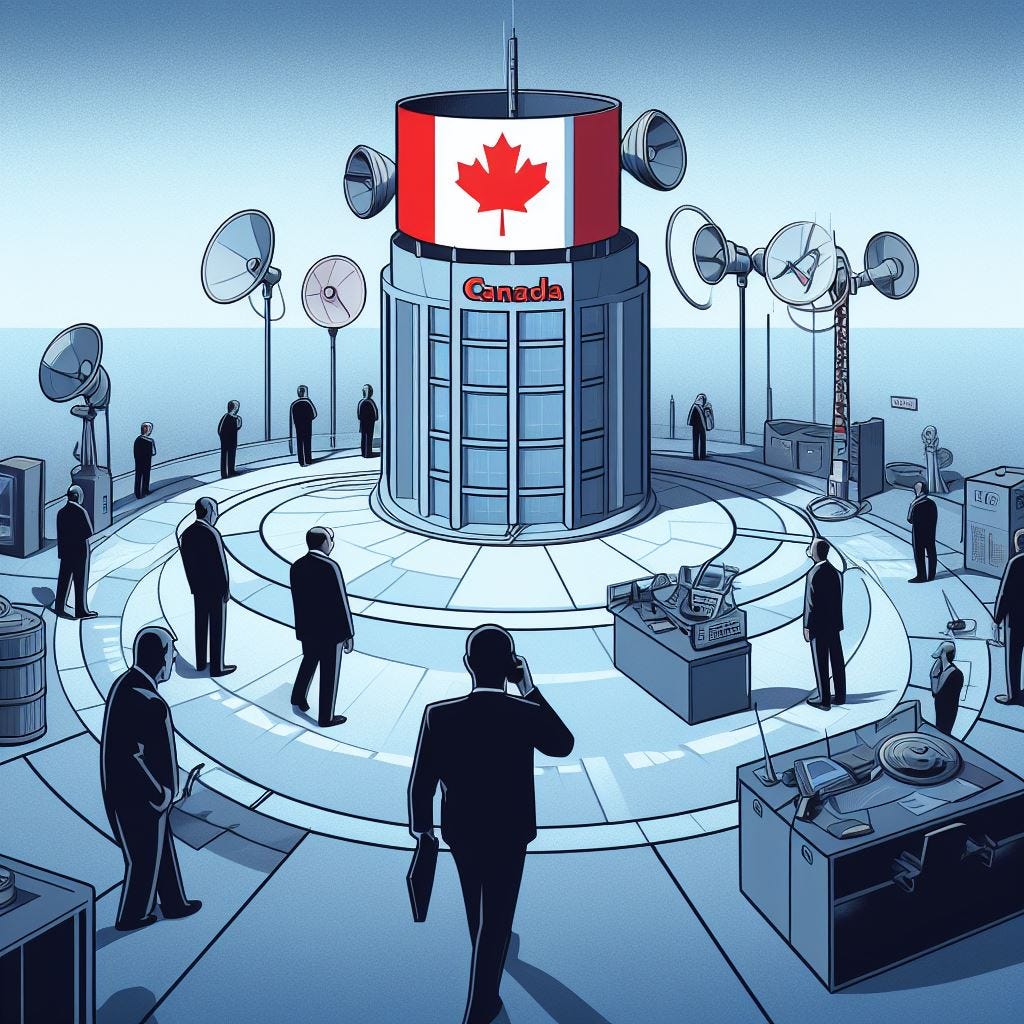Behind the Curtain: Canadian Lobbying in a Nutshell
A brief look at rules and watchdogs for lobbying in Canada and the lobbying efforts of Bell, Telus, and Rogers
A look into the murky world of lobbying in Canada. How it works, who’s in charge of monitoring lobbying, and how difficult it is to see what is going on.
Lobbying in Canada
When thinking about what to write about for my first set of articles, I came across a commercial for Rogers. This led me to think about how much influence Rogers has over telecoms in Canada. Rogers, along with Telus and Bell, have a virtual monopoly on Canada’s telecommunications infrastructure. Then it was down the rabbit hole of how The Big Three lobbied the Canadian government to keep their monopoly.
This week’s article will take a look at lobbying in Canada and try and answer some questions about how lobbying is conducted, by whom, and to what end. I'll end with a look at Rogers, Telus, and Bell's lobbying efforts with the help of the Office of the Commissioner of Lobbying of Canada’s registry of lobbyists.
What is Lobbying?
First and foremost, it is important to establish what exactly lobbying is. You may have a broad sense of it being business executives vying for government influence and influencing legislation to benefit their company’s interests. Although this is true it is not the full picture. Lobbying can take many forms and many names. Sometimes lobbyists are called government consultants, government relations advisors and lobby groups may be referred to as interest groups. They are all playing the same game; influencing government decision-making. The Office of the Commissioner of Lobbying in Canada defines lobbying as the following:
“Communicating with federal officials directly (written, spoken) or indirectly (appeals to the public) about a regulated matter such as a legislative proposal, bill or resolution, regulation, policy, program, awarding of grant contribution or other financial benefits, awarding of a contract and arranging a meeting between an official and any other person for a client or an employer”
As you can see this encompasses a significant amount of activities. It is important to note that not all who lobby are doing so for corporate profits. Some of those involved in lobbying include Non-government organizations lobbying for Canada to increase international aid efforts or unions seeking to promote the interests of their members be they milk farmers, healthcare workers, or retirees. Corporate interests do tend to dominate the lobbying space. Companies like the Royal Bank of Canada, Bank of Montreal, and Enbridge have more than a dozen registered lobbyists with the Office of the Commissioner of Lobbying of Canada. Unions also have a significant lobbying presence with the Canadian Union of Public Employees (Canada’s largest public sector union) having 17 registered lobbyists and Unifor (Canada’s largest private sector union) having almost 60.
Not anyone can be a lobbyist. Unless exempted by the Commissioner for Lobbying, you cannot be a lobbyist for 5 years after holding a position as a parliamentarian (Senate and House of Commons), ministerial staff, or senior public service executive. The caveat is that you are only considered a “lobbyist” if more than 20% of your duties involve lobbying public officials.
Finding the Big Players
Making a list of the most powerful lobby groups in Canada is not an easy task. The amount of lobbying done by interest groups varies from year to year depending on the current political climate and what legislation may or may not be in the works. There are some quality sources that I encourage you to look at to find out more about lobbying. The Office of the Commissioner of Lobbying in Canada (OCLC) has resources to find out information not only about groups lobbying but also who the individuals lobbying are, if they have ever held public offices, who they reached out to, what methods were used, and what subjects were discussed. However, the database does not sort by organization making it difficult to determine which entity has the most lobbyists or conducted the most lobbying. The only thing that is clear is that lobbying is happening more than ever before.
According to their 2022-23 Annual Report:
“Throughout the 2022-23 fiscal year, new records were set for both active registrations and active lobbyists. Each month revealed a new record for the number of active registrations for that particular month, with an all-time high of 5,508 active registrations in February 2023 and an all-time high of 7,707 active lobbyists in January 2023.”
Unfortunately, OCLC does not provide a breakdown of their information according to what entities do the most lobbying. It does, however, break down the subject matters lobbyists plan to discuss when they register and communications reports. The subjects most often brought up are Environment, Economic Development, Energy, Industry, and Health. The subjects are rather broad and looking at the top-5 government institutions in communication reports does not help much either. Those are the House of Commons, Innovation Science and Economic Development Canada, Environment and Climate Change Canada, Finance Canada, and Natural Resources Canada. Using the database to find who the top lobbying groups are is possible but would take more time than I have available and may be the subject of a later piece.
The way the database is set up along with what needs to be reported makes it difficult to estimate the impact that lobbying has on Canadian politics. Trying to answer the simple question of who has lobbied the most in Canada this year becomes a long and time-consuming exercise. Instead, I thought it would be worthwhile to set my sights on one sector in particular and what their efforts in lobbying have looked like. I have chosen to look at the telecommunications industry because it is dominated by three key companies: Rogers Communications Inc., Bell Canada, and Telus Corporation making comparing and contrasting all three much easier.
You can learn some interesting things about these companies through the lobbyist registry. First off we can see that Telus is by far the smallest of the three companies. Telus has not received any government funding this fiscal year and is not expected to. They list only 10 lobbyists in the registry with three of them having previously held public offices. These roles have all been within the House of Commons as assistants to members of parliaments. Bell Canada on the other hand will by the end of the current fiscal year have received just shy of $1 million from government institutions and they received around $12 million last year. Rogers received even more funding from government institutions receiving more than $23 million this year. Of course, the fact that these companies have received government funding should not raise suspicion. However, it is interesting to note how the biggest receivers of government funding also have the largest amount of registered lobbyists.
According to the registry, Bell has 10 senior officers whose lobbying activities represent less than 20% of their duties and a further 7 senior officers and employees whose lobbying activities represent 20% or more of their duties. Rogers on the other hand has more than 40 senior officers whose lobbying activities represent less than 20% of their duties and another 9 whose lobbying activities represent 20% or more of their duties. Rogers has almost twice the number of registered lobbyists as Telus and Bell combined. From this, we can see that Rogers had a greater number of lobbyists and received a much greater amount of government funding than its two main competitors. Beyond data points and broad subjects of discussion, the database tells us who, what, and when but not really the why. Even with all this information in the database, it does not say what impact the lobbying had and if it was successful which is arguably the most important thing to know.
In conclusion, the Lobbyist Registry is a valuable resource but not without its limits. More transparency is needed on what activities are conducted to lobby officials, the extent of operations of individual companies, and a way to find out the direct links between lobbying efforts and government contracts. Lobbying in Canada is a complicated issue with an enormous potential to influence how the government spends and implements laws and more needs to be done to know the extent of its influence on government decision-making.
Although this analysis was fairly limited, I hope it provided some insight into how lobbying in Canada works or better yet piqued your interest enough to go learn more for yourself. It certainly has for me and I will definitely be making use of the lobbyist registry in the future and reading more on lobbying in Canada.
Additional Sources:
https://www.nationalobserver.com/2022/05/09/explainer/what-is-lobbying-canada
https://democracywatch.ca/lobbying-backgrounder/https





